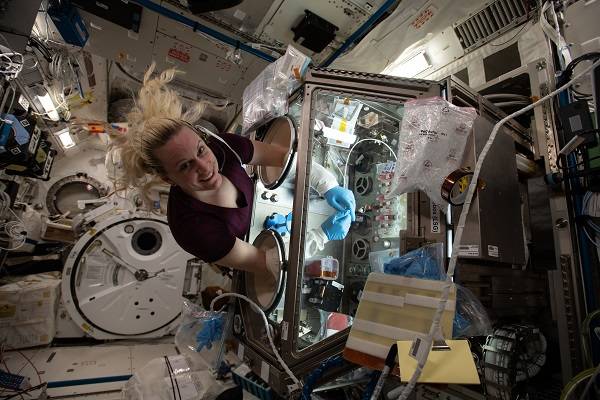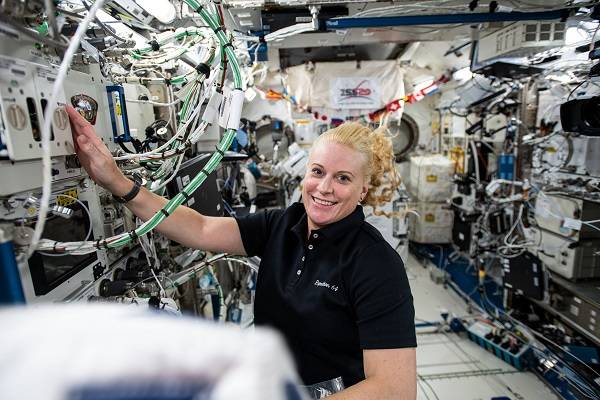ISS - International Space Station patch.
Apr 13, 2021
During the past six months, NASA astronaut Kate Rubins has embodied what it means to be an International Space Station scientist. She spent hundreds of hours working on space station experiments, talking with the researchers behind the studies, and serving as an ambassador for science in downlinks with the National Science Foundation, National Institutes of Health, Centers for Disease Control, and others. Rubins built on experiments she conducted during her first mission in 2016, working on new heart research and DNA sequencing.
International Space Station (ISS)
Rubins returns to Earth on April 17, 2021. As this phase of her journey comes to a close, take a look at the scientific studies she enabled during a research-filled stay in microgravity aboard the International Space Station.
A green thumb
Numerous plant growth experiments took place during Rubins’ time aboard station. She worked most on the Plant Habitat-02 experiment, tending to radishes as they grew in orbit and harvesting them for analysis back on Earth. This research could help optimize plant growth in space as well as evaluate the nutrition and taste of the plants.
Unraveling DNA
In 2016, Rubins became the first person to sequence DNA in space, eventually sequencing more than 2 billion base pairs of DNA as an Expedition 48 Flight Engineer. During expedition 64, Rubins built on her past work, conducting new DNA sequencing activities. With the ability to sequence DNA in space, astronauts could diagnose an illness, or identify microbes growing in the International Space Station and determine whether they represent a health concern. Watch as the research team behind these experiments takes a moment to recognize Rubins’ spot in scientific history.
Our heart beats for science
Rubins spent many hours with her arms in the Life Science Glovebox conducting the Cardinal Heart experiment. Cardinal Heart studies how changes in gravity affect cardiovascular cells at the cellular and tissue levels. Results could provide new understanding of heart problems on Earth, help identify new treatments, and support development of screening measures to predict cardiovascular risk prior to spaceflight.
In the bag
Gloveboxes and glove bags are important tools for keeping science-related materials contained on the space station. Here Rubins works in a glove bag on the MVP Cell-06 study. The experiment develops a biological model to study the effects of spaceflight on musculoskeletal disease. This investigation could lead to drugs to prevent the progression of this disease.
Welcome aboard, Crew-1
Rubins welcomed Crew-1 astronauts Michael Hopkins, Victor Glover, Shannon Walker, and Soichi Noguchi to station on November 17, 2020, when they arrived aboard the SpaceX Crew Dragon Resilience. The Commercial Crew Program provides increased crew time for science activities aboard the orbiting lab.
A commercial addition to station
NASA astronaut and fellow Expedition 64 crew member Victor Glover works alongside Rubins to configure and open the Nanoracks Bishop Airlock attached to the Tranquility module. Launched in the trunk of a SpaceX Dragon capsule, Bishop enables more commercial research, satellite deployments, and cargo operations outside in the vacuum of space.
Busy bees
Rubins poses with a pair of AstroBee robotic assistants inside the Japanese Kibo laboratory module. Researchers are testing the ability of the cube-shaped, toaster-sized robots to autonomously navigate and maneuver inside the orbiting lab. During Rubins’ mission, these robots were used for a number of experiments, including Gecko-Inspired Adhesive Grasping.
Hardware install
At the start of her mission, Rubins shared the space station with NASA astronaut Chris Cassidy. He snapped this picture of Rubins as she installed modules into Multi-use Variable-G Platform, a facility that can create artificial gravity for small experiments.
Picturing our planet
The top image taken by Rubins shows the coast of Chubut Province in Argentina. Rubins captured Hurricane Zeta as the category two storm churned in the Gulf of Mexico nearing Louisiana in the bottom image. Crew Earth Observations like these record how the planet is changing over time, from human-caused changes, such as urban growth and reservoir construction, to natural dynamic events, such as hurricanes, floods, and volcanic eruptions.
Putting materials to the test
Rubins pauses for a photo while prepping the Materials International Space Station Experiment Transfer Tray to head outside of the space station. The tray uses the JEM Airlock to slide payloads like this out of station and test how a variety of materials withstand the harsh environment of space.
Keeping science cold
Many scientific samples have to be kept cool until they can be analyzed back on Earth. Rubins helps with this process by loading engineered heart tissue samples into a science freezer for preservation. The science freezer, known as the Minus Eighty-Degree Laboratory Freezer for ISS (MELFI), maintains experiment samples at ultra-cold temperatures throughout a mission.
Mapping microbes
During this mission, Rubins took hundreds of microbial samples for the 3DMM study. The experiment provides sequencing and analyses on samples collected from 1,000 different locations within the space station. By advancing our understanding of the space station microbiome, this work helps identify potential risks and supports developing countermeasures to mitigate those risks.
Flame on!
In space, flames burn differently than they do on Earth. The space station is a great place to study these differences. Rubins removes research hardware from inside the Combustion Integrated Rack as she replaced gear to support a suite of fuel efficiency, pollution, and fire safety studies known as the Advanced Combustion in Microgravity Experiments (ACME).
Conquering colloids
Rubins sets up the ACE-T-Ellipsoids study inside the Light Microscopy Module. The investigation designs and assembles complex three-dimensional colloids – small particles suspended within a fluid medium – and controls density and behavior of the particles with temperature. Studying colloids on Earth is complicated by gravity, which causes some particles to rise and others to sink. Microgravity takes away that complication and makes possible research that can help companies design better products.
Kate Rubins Scientist in Space
Although Rubins’ latest chapter of research aboard the orbiting laboratory ends with her return to Earth, her participation in human research continues as scientists monitor her acclimation back to gravity for months – or even years – after landing. Science aboard the space station also continues. Innovative investigations that seek to benefit humans on Earth and further our exploration of the solar system are ongoing. Follow @ISS_Research to keep up with the science happening aboard your orbiting laboratory.
Related links:
Expedition 64: https://www.nasa.gov/mission_pages/station/expeditions/expedition64/index.html
Commercial Crew Program: https://www.nasa.gov/exploration/commercial/crew/index.html
Plant Habitat-02: https://www.nasa.gov/mission_pages/station/research/experiments/explorer/Investigation.html?#id=7793
Cardinal Heart: https://www.nasa.gov/mission_pages/station/research/experiments/explorer/Investigation.html?#id=8218
MVP Cell-06: https://www.nasa.gov/mission_pages/station/research/experiments/explorer/Investigation.html?#id=8273
Nanoracks Bishop Airlock: https://www.nasa.gov/mission_pages/station/research/experiments/explorer/Facility.html?#id=7420
AstroBee: https://www.nasa.gov/mission_pages/station/research/experiments/explorer/Facility.html?#id=1891
Gecko-Inspired Adhesive Grasping: https://www.nasa.gov/mission_pages/station/research/experiments/explorer/Investigation.html?#id=7840
Multi-use Variable-G Platform: https://www.nasa.gov/mission_pages/station/research/experiments/explorer/Facility.html?#id=1777
Crew Earth Observations: https://www.nasa.gov/mission_pages/station/research/experiments/explorer/Investigation.html?#id=84
Minus Eighty-Degree Laboratory Freezer for ISS (MELFI): https://www.nasa.gov/mission_pages/station/research/experiments/explorer/Facility.html?#id=56
3DMM: https://www.nasa.gov/mission_pages/station/research/experiments/explorer/Investigation.html?#id=8345
Advanced Combustion in Microgravity Experiments (ACME): https://www.nasa.gov/mission_pages/station/research/experiments/explorer/Investigation.html?#id=1651
ACE-T-Ellipsoids: https://www.nasa.gov/mission_pages/station/research/experiments/explorer/Investigation.html?#id=8166
Space Station Research and Technology: https://www.nasa.gov/mission_pages/station/research/overview.html
International Space Station (ISS): https://www.nasa.gov/mission_pages/station/main/index.html
Images, Video, Text, Credits: NASA/Ana Guzman/ESA/JSC/International Space Station Program Research Office/Erin Winick.
Greetings, Orbiter.ch




















